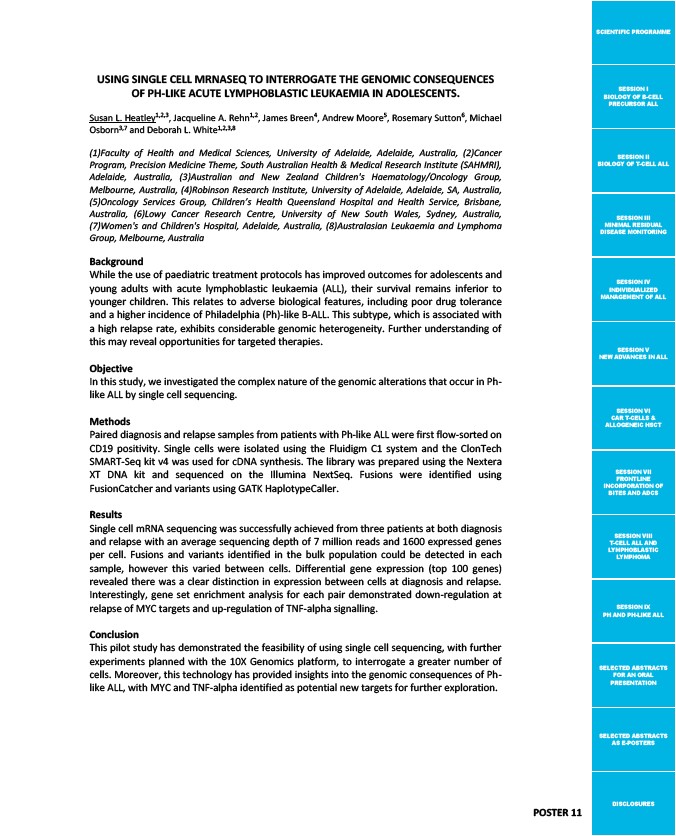
SCIENTIFIC PROGRAMME
SESSION I
BIOLOGY OF B-CELL
PRECURSOR ALL
SESSION II
BIOLOGY OF T-CELL ALL
SESSION III
MINIMAL RESIDUAL
DISEASE MONITORING
SESSION IV
INDIVIDUALIZED
MANAGEMENT OF ALL
SESSION V
NEW ADVANCES IN ALL
SESSION VI
CAR T-CELLS &
ALLOGENEIC HSCT
SESSION VII
FRONTLINE
INCORPORATION OF
BITES AND ADCS
SESSION VIII
T-CELL ALL AND
LYMPHOBLASTIC
LYMPHOMA
SESSION IX
PH AND PH-LIKE ALL
SELECTED ABSTRACTS
FOR AN ORAL
PRESENTATION
SELECTED ABSTRACTS
AS E-POSTERS
DISCLOSURES
USING SINGLE CELL MRNASEQ TO INTERROGATE THE GENOMIC CONSEQUENCES
OF PH-LIKE ACUTE LYMPHOBLASTIC LEUKAEMIA IN ADOLESCENTS.
Susan L. Heatley1,2,3, Jacqueline A. Rehn1,2, James Breen4, Andrew Moore5, Rosemary Sutton6, Michael
Osborn3,7 and Deborah L. White1,2,3,8
(1)Faculty of Health and Medical Sciences, University of Adelaide, Adelaide, Australia, (2)Cancer
Program, Precision Medicine Theme, South Australian Health & Medical Research Institute (SAHMRI),
Adelaide, Australia, (3)Australian and New Zealand Children's Haematology/Oncology Group,
Melbourne, Australia, (4)Robinson Research Institute, University of Adelaide, Adelaide, SA, Australia,
(5)Oncology Services Group, Children’s Health Queensland Hospital and Health Service, Brisbane,
Australia, (6)Lowy Cancer Research Centre, University of New South Wales, Sydney, Australia,
(7)Women's and Children's Hospital, Adelaide, Australia, (8)Australasian Leukaemia and Lymphoma
Group, Melbourne, Australia
Background
While the use of paediatric treatment protocols has improved outcomes for adolescents and
young adults with acute lymphoblastic leukaemia (ALL), their survival remains inferior to
younger children. This relates to adverse biological features, including poor drug tolerance
and a higher incidence of Philadelphia (Ph)-like B-ALL. This subtype, which is associated with
a high relapse rate, exhibits considerable genomic heterogeneity. Further understanding of
this may reveal opportunities for targeted therapies.
Objective
In this study, we investigated the complex nature of the genomic alterations that occur in Ph-like
ALL by single cell sequencing.
Methods
Paired diagnosis and relapse samples from patients with Ph-like ALL were first flow-sorted on
CD19 positivity. Single cells were isolated using the Fluidigm C1 system and the ClonTech
SMART-Seq kit v4 was used for cDNA synthesis. The library was prepared using the Nextera
XT DNA kit and sequenced on the Illumina NextSeq. Fusions were identified using
FusionCatcher and variants using GATK HaplotypeCaller.
Results
Single cell mRNA sequencing was successfully achieved from three patients at both diagnosis
and relapse with an average sequencing depth of 7 million reads and 1600 expressed genes
per cell. Fusions and variants identified in the bulk population could be detected in each
sample, however this varied between cells. Differential gene expression (top 100 genes)
revealed there was a clear distinction in expression between cells at diagnosis and relapse.
Interestingly, gene set enrichment analysis for each pair demonstrated down-regulation at
relapse of MYC targets and up-regulation of TNF-alpha signalling.
Conclusion
This pilot study has demonstrated the feasibility of using single cell sequencing, with further
experiments planned with the 10X Genomics platform, to interrogate a greater number of
cells. Moreover, this technology has provided insights into the genomic consequences of Ph-like
ALL, with MYC and TNF-alpha identified as potential new targets for further exploration.
POSTER 11